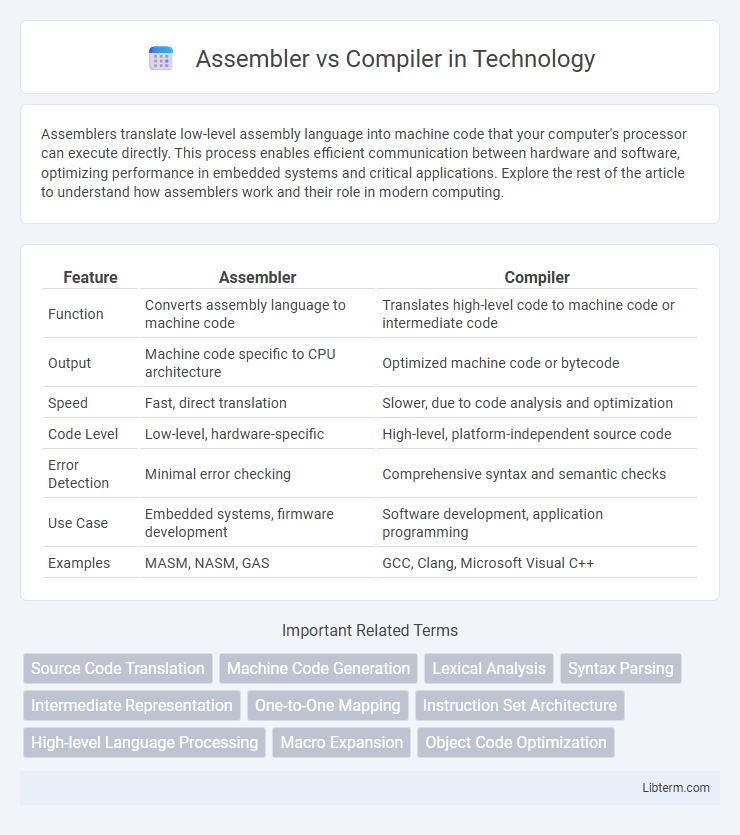Assemblers translate low-level assembly language into machine code that your computer's processor can execute directly. This process enables efficient communication between hardware and software, optimizing performance in embedded systems and critical applications. Explore the rest of the article to understand how assemblers work and their role in modern computing.
Table of Comparison
| Feature | Assembler | Compiler |
|---|---|---|
| Function | Converts assembly language to machine code | Translates high-level code to machine code or intermediate code |
| Output | Machine code specific to CPU architecture | Optimized machine code or bytecode |
| Speed | Fast, direct translation | Slower, due to code analysis and optimization |
| Code Level | Low-level, hardware-specific | High-level, platform-independent source code |
| Error Detection | Minimal error checking | Comprehensive syntax and semantic checks |
| Use Case | Embedded systems, firmware development | Software development, application programming |
| Examples | MASM, NASM, GAS | GCC, Clang, Microsoft Visual C++ |
Introduction to Assemblers and Compilers
Assemblers translate assembly language, a low-level human-readable code, directly into machine code executed by the CPU. Compilers convert high-level programming languages, such as C++ or Java, into machine code or intermediate code for efficient execution. Both tools optimize code translation but serve different abstraction levels, with assemblers targeting hardware-specific instructions and compilers handling complex language syntax and semantics.
Definition of Assembler
An assembler is a software tool that translates assembly language, a low-level human-readable code, into machine code readable by a computer's processor. Unlike compilers that convert high-level programming languages into machine code, assemblers work directly with symbolic instructions specific to a particular CPU architecture. Assemblers are essential for tasks requiring direct hardware manipulation, optimized performance, and precise control over system resources.
Definition of Compiler
A compiler is a software tool that translates high-level programming languages like C++ or Java into machine code, enabling direct execution by the computer's processor. Unlike assemblers that convert assembly language, compilers perform complex optimizations and syntax checks to improve code efficiency and detect errors. The output of a compiler is typically an executable or object file ready for linking and running on a specific hardware platform.
Key Differences Between Assembler and Compiler
Assemblers translate low-level assembly language directly into machine code with a one-to-one correspondence between instructions, while compilers convert high-level programming languages into machine code through multiple stages including lexical analysis, syntax analysis, and optimization. Assemblers typically produce faster and smaller output, ideal for system-level programming, whereas compilers support complex language constructs, data types, and error checking essential for application development. The key difference lies in their input language abstraction level and translation process complexity, with assemblers working closely to the hardware and compilers handling more abstract, human-readable code.
Translation Process: Assembly vs Compilation
The translation process in assembly involves converting mnemonic instructions directly into machine code through a one-to-one mapping, resulting in highly efficient and hardware-specific output. Compilation transforms high-level language code into machine code by performing lexical analysis, syntax analysis, semantic analysis, optimization, and code generation, which produces more portable but often less hardware-tailored executables. Assemblers translate source code faster with less complexity, while compilers handle complex programming constructs with multiple intermediate representations.
Speed and Efficiency Comparison
Assemblers translate low-level assembly code directly into machine code, resulting in faster execution speed and higher efficiency due to minimal abstraction layers. Compilers convert high-level languages into machine code through complex optimization processes, which can produce slower runtime performance but enable more advanced optimizations for complex applications. Generally, assembler-generated code is leaner and faster for specific hardware tasks, while compiler-generated code offers improved scalability and maintainability at the cost of some execution speed.
Error Detection and Debugging
Assembler translates low-level assembly code directly into machine language, offering limited error detection primarily for syntax issues, which makes debugging less intuitive and more time-consuming. Compiler converts high-level source code into machine code but includes extensive error detection and reporting mechanisms, allowing developers to identify and resolve syntax, semantic, and logical errors more efficiently. Debugging in compiled languages benefits from advanced tools such as breakpoints, variable inspection, and stack tracing, enhancing error tracking compared to the more manual process associated with assembly language.
Output File Formats
Assemblers generate object files typically in machine code format such as ELF, COFF, or PE, which are platform-specific and closely represent the processor's instructions. Compilers produce output in several formats including intermediate representations like LLVM IR or high-level bytecode (e.g., Java bytecode), and native machine code executable files such as ELF, PE, or Mach-O. The choice of output format depends on the target platform and intended use, where assemblers focus on direct hardware instructions and compilers often provide additional abstraction layers for optimization and portability.
Use Cases and Applications
Assemblers are primarily used for low-level programming tasks such as embedded systems, device drivers, and hardware interfacing, where direct control over hardware resources and memory management is crucial. Compilers are suited for high-level application development including desktop software, web applications, and large-scale enterprise systems, as they translate high-level languages like C++, Java, or Python into optimized machine code. Use cases for assemblers emphasize performance-critical operations and resource-constrained environments, while compilers support complex application logic, portability, and ease of maintenance.
Conclusion: Choosing Between Assembler and Compiler
Choosing between assembler and compiler depends on the specific requirements of the project, where assemblers offer low-level control and optimized performance for hardware-specific applications, while compilers provide greater abstraction and ease of use for high-level programming languages. Assemblers translate mnemonic code directly into machine code, making them ideal for tasks needing precise hardware manipulation, whereas compilers convert entire high-level programs into machine code, supporting complex software development. Developers prioritize assemblers for speed and efficiency in embedded systems, while compilers are preferred for portability and scalability in general software engineering.
Assembler Infographic

 libterm.com
libterm.com